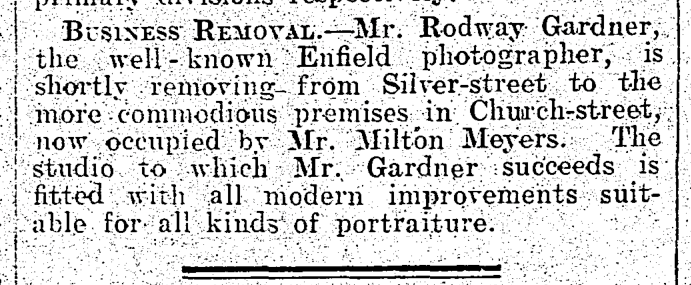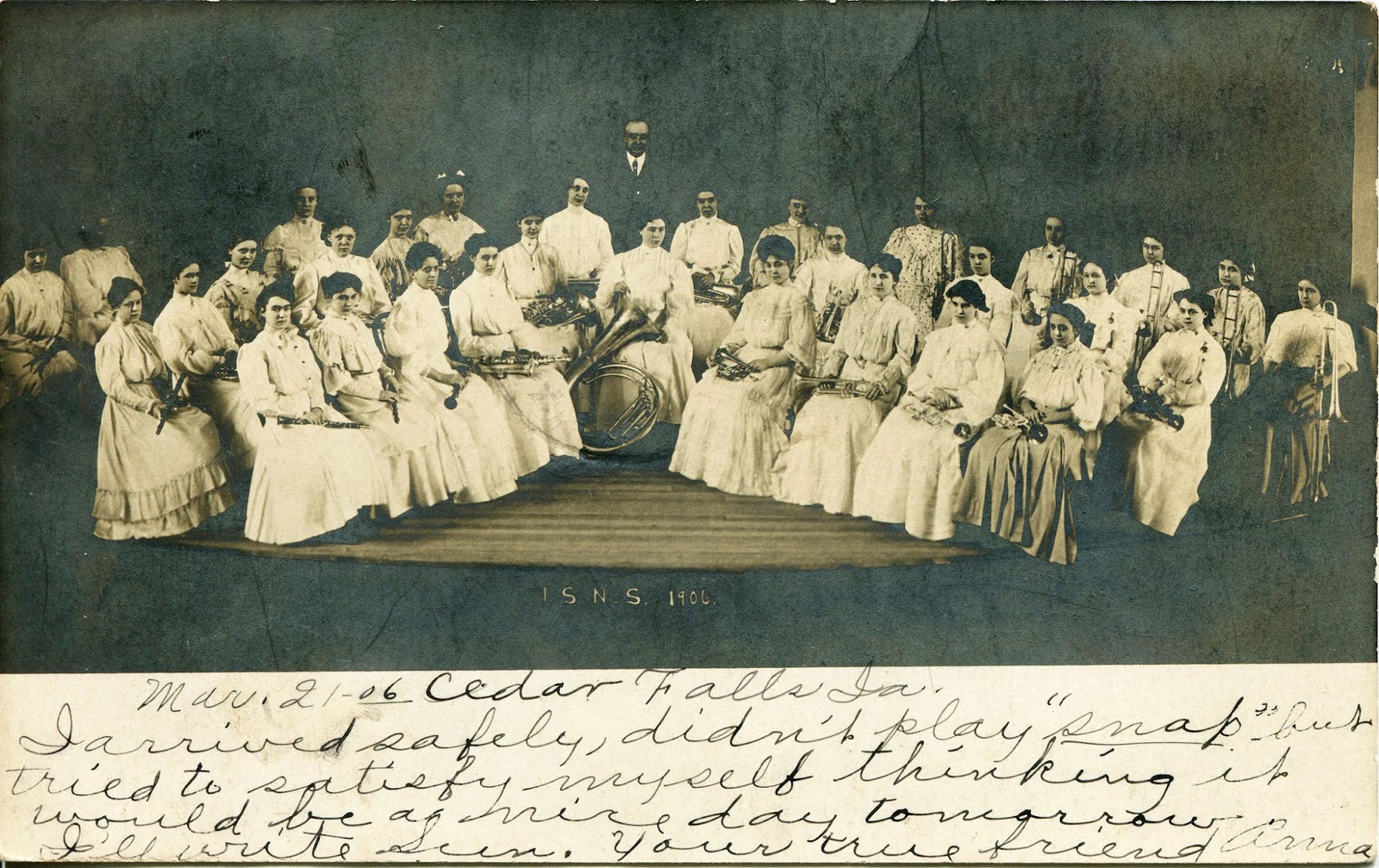Concert dress is a common phrase on a musician's contract. For generations of men this uniform description has translated into either white tie and tails or black tie and tuxedo. Women musicians however, have always enjoyed more variety in fashion. This young lady is a violinist from either Niles or Buchanan, Michigan - two small towns separated by a bow in the St. Joseph River. Her hair is short and set in neat waves, possibly pinned at the back. She also wears pendant earrings which in today's musicians union contracts would be forbidden as too distracting. Her puff sleeves and wide collar suggest a fashion from around 1895.
The photography studio marked on this cabinet card says Elson – Niles/Buchanan, Mich. which stands for Elon J. Elson who was a photographer in Buchanan from 1896 to 1905. His wife ran a millinery shop and he later opened a jewelry store, so he must have known something about women's taste in fashion.
This second young woman played the violin at about the same time as the Michigan violinist, but she lived some distance away in London, England. Like the other woman, her wavy hair is cut short which would be a practical hair style for a violinist. The photo's sepia tone makes her dress appear black but it could be another dark color too. The sleeve style is reversed with tight shoulders and blousy wrists, and would not be out of place on a concert stage today.
The back of this cabinet card photo has an nice Art Nouveau design with a woman gazing at a painting or photograph of another woman and the name of the studio – Nye & Co. Photographers of 116 Walworth Road, London S.E. which is in south London below the Elephant & Castle underground station. The address was used first by Hanover Studio operated by Richard Roberts Willson from about 1883 to 1895; then Thomas John Nye took over from 1895 until 1906; and then he was succeeded by Henry Brown in 1907. So a date for the photo of 1900 would seem reasonable.
Hemlines gradually rose higher in the 20th century, and this young violinist wears a more modern dress that reveals her ankles in a way the previous two women might have thought very adventurous if not scandalous. Her hair style is short and would not be out of place in our time. The dress has a color I think and is not black. It has different fabrics including a transparent effect at the shoulders, but the best part is the line of small pompons sewn to her sleeve that would accentuate the movement of her bow arm. It makes me think she was a professional violin soloist. My guess for this fashion would be 1917 to probably post-WW1 1925.
In the lower right corner of this postcard photo is an embossed logo for the photographer that I nearly missed until I scanned and enlarged the postcard photo. It says Rodway Gardner, Enfield which is the only clue that this violinist is most likely English. Enfield is about 14 miles north of central London in Middlesex, England.
 |
| The Middlesex Gazette Dec. 26, 1908 |
Mr. Rodway Gardner was born in 1861 and died in 1945 and was a professional photographer in Enfield from at least 1902, possibly much earlier, to after 1912. He managed to regularly get his name mentioned in the Middlesex Gazette newspaper. Usually as a photographer, but more often as a singer, a tenor to be specific. His name appears in several reviews of amateur or semi-professional concerts and in advertisements like this one for a variety show from November 20, 1909.
 |
| The Middlesex Gazette Nov. 20, 1909 |
Perhaps the young lady is Miss Nettie Carpenter the featured violin soloist. In any case she must surely be a musical colleague of Mr. Gardner.
I believe that this last violinist is also English as the photo came from a dealer in the UK. Her short hair style has a definite 1920's look, maybe even 1930s. Her dress line is higher with short sleeves that show her bare arms which again would direct the eyes to the motion of a violinist's bow. What is interesting is that she stands not in front of a photographer's studio backdrop but in a drawing room in front of a small spinet, a type of harpsichord.
 |
| English Spinet Source: Edinburgh University Collection of Historic Musical Instruments |
The spinet was a keyboard instrument played from around 1600 to 1800 and designed for quiet chamber music in a household. Like all harpsichords it disappeared from the music of the late 18th and 19th centuries in favor of the piano. The music of the Renaissance and Baroque eras had a resurgence in the 20th century with the start of what is called the Early Music movement in Britain. The placement of this unusual instrument in the photo leads me to believe this violinist was an accomplished solo musician who performed this kind of novel antique music and that she may even hold a Baroque style violin.
The photo was mounted on thin paper and the photographer's penciled
signature is too artistic to be readable. Perhaps J_Tasil ?
Maybe one day I will come across another photograph and recognize either the woman's face or the signature and then be able to identify her. What do you suppose she kept in her dress pockets? Gum?
This is my contribution to Sepia Saturday
where other women are letting their hair down.
where other women are letting their hair down.














































